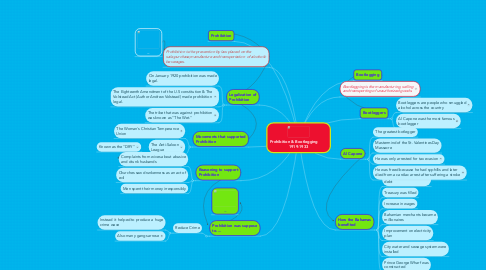Prohibition & Bootlegging 1919-1933
by JLN history

1. Prohibition
2. Legalization of Prohibition
2.1. On January 1920 prohibition was made legal.
2.2. The Eighteenth Amendment of the U.S constitution & The Volstead Act (Author Andrew Volstead) made prohibition legal.
2.3. The tribe that was against prohibition was known as "The Wet."
3. Movements that supported Prohibition
3.1. The Woman's Christian Temperance Union
3.2. The Anti-Saloon League
3.2.1. Known as the "DRY"
4. Reasoning to support Prohibition
4.1. Complaints from wives about abusive and drunk husbands
4.2. Churches saw drunkenness as an act of evil
4.3. Men spent their money irresponsibly
5. Prohibition was suppose to....
5.1. Reduce Crime
5.1.1. Instead it helped to produce a huge crime wave
5.1.2. Also many gangs arrose
6. hi
7. __
8. __
9. Prohibition is the prevention by law placed on the sale,purchase,manufacture and transportation of alcoholic beverages.
10. Bootleggers
10.1. Bootleggers are people who smuggled alcohol across the country
10.2. Al Capone was the most famous bootlegger
11. Bootlegging
12. Bootlegging is the manufacturing, selling and transporting of unauthorized goods.
13. How the Bahamas benefited
13.1. Government cleared their debt
13.2. Treasury was filled
13.3. Increase in wages
13.4. Bahamian merchants became millionaires
13.5. Improvement on electricity plan
13.6. City water and sewage system were installed
13.7. Prince George Wharf was constructed
14. Created by:
14.1. Nadira Bowlin
14.2. Janique Ellis
14.3. Lotalenia Moss
15. Al Capone
15.1. The greatest botlegger
15.2. Mastermind of the St. Valentines Day Massacre
15.3. He was only arrested for tax evasion
15.4. He was freed because he had syphillis and later died from a cardiac arrest after suffering a stroke


